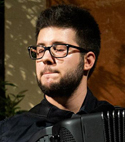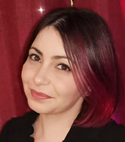  
Interview: Romuald Lefebvre 1. You started early the study of the accordion. Why did you choose this musical instrument? I would say that I was immersed in music at a very young age. My father listened to various kinds of music. He was also an amateur musician. He owned and played several musical instruments at home: piano, guitar, accordion and harmonica. I felt in love with the accordion. What has always fascinated me is the accordion in the classical repertoire or in jazz music and also in its role as an accompanying instrument. 2. You have studied the accordion with one of the best exponents of this instrument: Max Bonnay. Tell us about your relationship with such an authoritative teacher. Indeed, studying with one of the best exponents of the accordion was one of my childhood dreams. When I was young, I continuously told my parents that being a student of Max Bonnay would be my main objective and would be some kind of recognition for my work. So, I worked hard and played the accordion between 6 and 8 hours a day to achieve my objective and make my dream come true. Having met Max Bonnay during competitions or Master-classes, I eventually joined his class in 2004 in the "12th arrondissement" school of Paris. Before the opening of the accordion class at the Conservatoire Nationale Supérieure de Musique de Paris, the "12th arrondissement" school with Max Bonnay as its accordion teacher trained the prestigious accordionists and winners of international competitions such as Mika Vayrynen, Angel Luis Castano, Massimiliano Pitocco and many others. Max has always been very attentive, finding the right words to make me move forward, to motivate me. I have a deep respect for him because I owe him a lot. Moreover, I am still in contact with him within the UNAF, currently chaired by his sister Christiane. Video: Romuald Lefebvre performing Winter by Antonio Vivaldi. Extract of the solo album "Toccata". 3. Throughout your career you have dealt with different musical environments and styles, from theater to classical music, up to collaborating for the recordings of soundtracks. What is the environment and musical style that you prefer and in which you feel most comfortable? Indeed, I had and I have the chance to play different repertoires. I don't necessarily have a stylistic preference, the music has to speak to me, to touch me and to inspire me. Even if it requires a lot of work, I like the solo repertoire, but I also like playing in tango quintet, jazz group or with orchestras. But if I had to choose, I would say that I feel more comfortable with classical music.  4. Along your career you have had the opportunity to meet and work with prestigious personalities such as Juan José Mosalini. Tell us your memories related to this professional and human experience. I met and worked with Juan José Mosalini during my studies. The project was based on Piazzola's repertoire. We rehearsed a lot to offer a high-quality concert. I was still a student at that time, and I worked on the style of the tango with Juan José. I can say that I met a great man. He was humble and very kind. I remember the first time he heard me playing. He looked at everyone in the room and said "Romuald, you will replace me on a piece. I want you to perform the piece "Bando" as a soloist with the string orchestra." It was an honour. It's one of my fondest memories. Opéra de quat' sous de Kurt Weill. Concert presented by Laurent Valière on the 42e rue program, October 30 at 11 a.m. at Studio 106, Maison de la Radio. With Gilles Bugeaud, Pauline Gardel, Vincent Heden, Nolwenn Korbell, Amélie Munier, Florence Pelly, Jean Sclavis, Jacques Verzier. 5. In addition to your career as a concert performer, you have also decided to devote yourself to teaching, and you are currently an accordion teacher at the Conservatoire. How do you relate to your students and what do you try to convey the most? I am currently teaching in the Conservatoires of Calais and Boulogne-Sur-Mer.  I try as much as possible to have a very good relationship with my students so that they give the best of themselves. I think that it is always easier to give the best of yourself in a trustworthy and respectful relationship. I also try to show and teach them what seems to me essential to be a good musician : organised, demanding and hard-working. To motivate them, I like to have them meet renowned artists too. Thanks to friends of mine, like Philippe Imbert, my reapir technician, and the support of the accordion company Bugari Armando, I was able to invite to the conservatoires where I teach, Marie Andrée Joerger, Teodoro Anzellotti, Sergio Petronio and Philippe Bourlois. 6. Surely you are very attentive and involved in the development of the accordion. Tell us about the "Professors of Haut de France" project. It is an association that I created with the accordionist Vincent Lhermet. The first goal of it is to standardize the teaching of the accordion in the Hauts-de-France region. I have been teaching the accordion for 23 years now and Vincent asked me for a report on the teaching of the accordion in the region. What I noticed, is that the levels were very often heterogeneous according to the different juries or schools. What bothered me, is that if a student wanted to enter a conservatoire, it could be difficult because of the difference of levels between the schools, 2- or 3-years of courses for the same name diploma. So, thanks to the association, we worked on the standardization of teaching and levels. We keep on working and we will organize a project in 2024 at the Conservatoire of Lille in order to bring together a maximum of classes and students. This association is currently chaired by Mélanie Brégant. 7. In 2013 and 2014 you released two solo albums, entitled "Ecletic" and "Toccata". Can you explain in detail the characteristics of these two albums? The solo album "Eclectic" released in 2013 brings together a set of pieces that I had to work on for a competitive exam in France. I wanted to take advantage of this to work on an album from the conception to the production of it. This album includes works by Bach, Brahms, Biloschizki, Astier, Galliano and many others. The second album "Toccata" one year later, brings together various pieces. I worked some of then with Max Bonnay and I performed them several times. Some of these pieces were required music in international competitions or the CNSM in Paris. This second album opened doors for collective projects or chamber music. I had the opportunity to perform with the Philharmonic Orchestra of Radio France in Paris and Montpellier conducted by Wladimir Fedoseyev. I was also recruited in an opera, more precisely the opera "Quat'sous" of Kurt Weil and Bertolt Brecht with which I went on tour twice in France and Belgium. 8. Do you have plans for the future?  Of course, I am still very active. I keep on playing my instrument 4 to 5 hours every day. Last weekend, for example, I played Rossini's solemn mass with piano, choir and soloists. There will be other concerts in November and in 2024. I have a duet with a friend of mine and trumpet player, Samir Ferhahi. We perform trumpet pieces from Albinoni, Arban as well as creations. Moreover, I am working on the 4 seasons of Antonio Vivaldi transcribed by Victor Romanko and this project is close to my heart. |